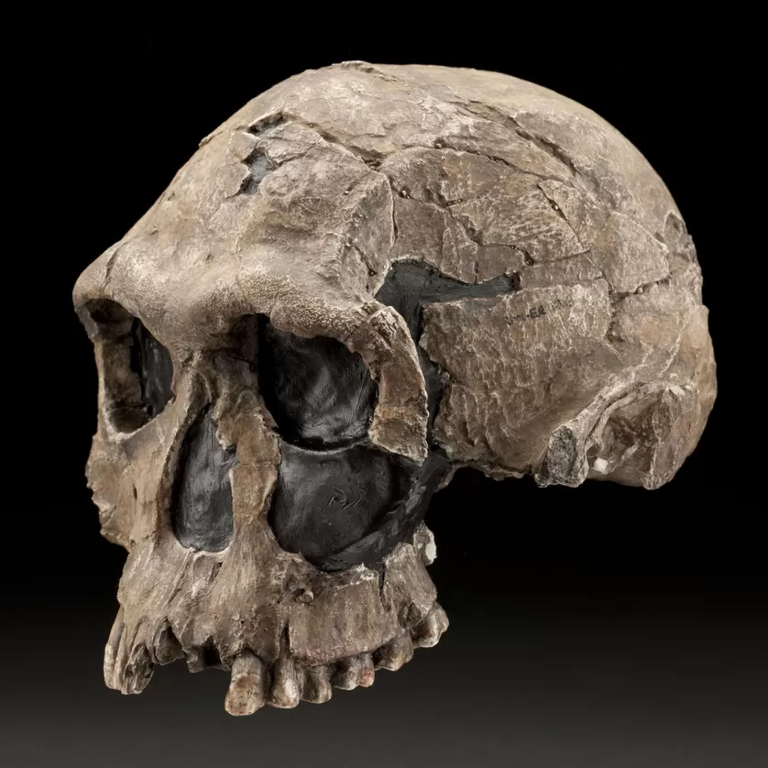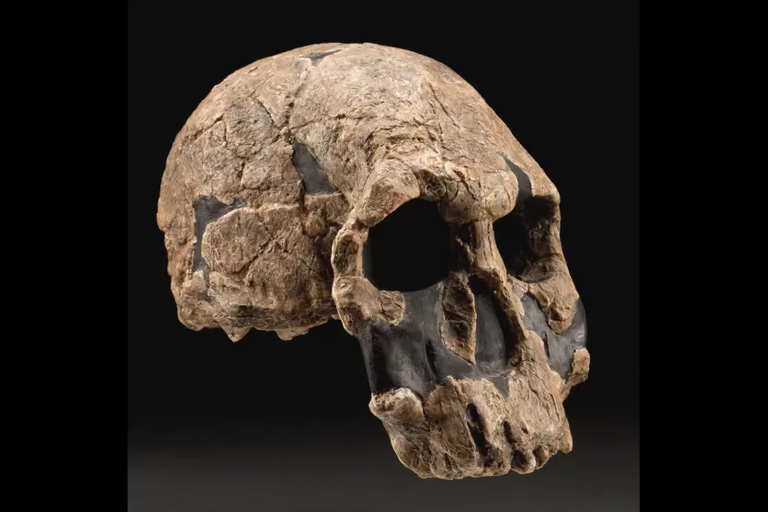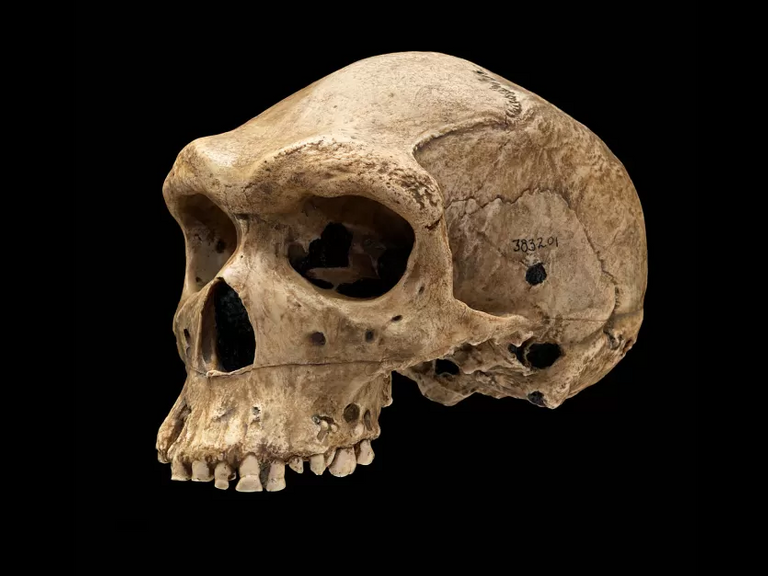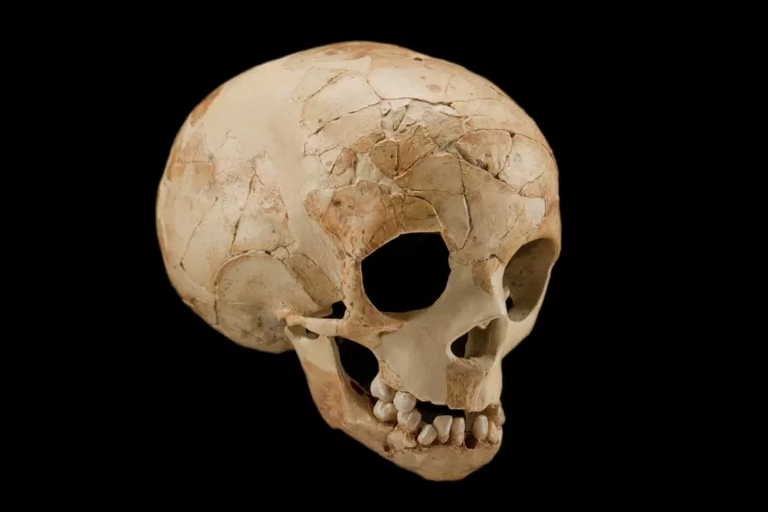
Understanding how humans evolved is critical to our history as humans, but it is also essential to studying evolution. I want to start the exhibit with Plesiadapiforms because Plesiadapiforms are the first primate to appear in the fossil record 55 mya. Plesiadapiforms were much different from the primates we are familiar with today. Plesiadapiforms had eyes that faced to the sides and not forward-facing eyes like modern primates. Plesiadapiforms had eyes not encased in bone; they had no postorbital bones. Plesiadapiforms had protracted narrow snouts suggesting they relied on their sense of smell for survival, unlike modern primates who do not rely on their sense of smell as much because they are arboreal, which is why modern primates have short snouts.
Plesiadapiforms had small brains and large incisors; they had claws instead of the flat nails like modern primates have and lacked sufficient grappling abilities. Some Plesiadapiforms have shown the ability to grab things, and some Plesiadapiforms have an opposable big toe with a flat nail. When Plesiadapiforms grew into Prosimians during the Eocene epic, it's evident that natural selection chose to carry the opposable thumb and flat nail genes onto the Prosimians and gave us our first confirmed primate species that shared the same characteristics as modern primates. Showing the evolution of primates from Plesiadapiforms to Prosimians would exhibit to museum-goers evidence of evolution in primates and how primates became a unique species in the animal kingdom.
Proconsulids appear in the fossil record around 23 mya, and they are the first primate species to have many shared features with modern humans and apes. Proconsulids had bigger brains than early primates like the Aegyptopithecus or Plesiadapiforms, and their tail had been replaced by a fleshy sitting pad similar to modern apes and humans. Proconsulid's fossil records and dentition suggest that they were arboreal quadrupeds that ate fruit as part of their main diet. Humans and apes evolved from Proconsulids during the Miocene epoch in Africa, which is why Procosulids are considered to be early hominoids. A brief history of the evolution from Plesiadapiforms to Prosimians and Proconsulids is critical to a museum exhibit about how humans evolved even though this evolution took place between 20 and 55 mya because without the evolution of Plesiadapiforms to Prosimians and Proconsulids primates as we know them may not exist.
Oreopithecus are another critical species that emerge in the fossil record around twelve million years ago, and they had a morphology that supported suspensory locomotion, allowing them to hang and swing from tree branches. Oreopithecus had dentition that suggested they could eat more fibrous vegetation an adaptation that was vital to eating things that were harder to chew— and the evolution of the primate diet. Sivapithecus is believed to have evolved from Oreopithecus, and the Sivapithecus is an ancestor of the modern-day orangutan. Sivapithecus is the first primate to show evidence in its fossil record that this species spent a lot of time on the ground and in the trees. Sivapithecus had large canines and heavy molars, a dentition that supported eating seeds and grasses.
Showing the evolution of the primate species from Plesiadapiforms to Sivapithecus gives museum-goers a clear picture of how primates evolved and has visual aspects that will resonate with visitors. Natural selection is apparent just by looking at the fossil record. For example, some Plesiadapiforms did not have opposable thumbs, and some did, but when the species evolved into Prosimians, they had opposable thumbs. Plesiadapiforms, Prosimians, and Aegyptopithecus zeuxis all had tails, but when the primate species evolved into Oreopithecus, the tail had been abandoned by natural selection in favor of a fleshy sitting pad. Natural selection decided that early primates did not need a tail and if this adaptation to living on the ground had not taken place the evolution from being quadrupedal to a bipedal species may have taken longer or not happened at and all that is why it is important to include this evolutionary adaptation in the human evolution exhibit. Early adaptations in our evolution like the opposable thumb of the Plesiadapiforms or the orbital bone of the Prosimians and the fleshy sitting pad of Oreopithecus paved the way for primates to become the intricate species they are today and they are simple easy to comprehend cases of natural selection high school students will be able to understand.
In the 1960s, a team of scientists led by Louis and Mary Leakey redefined the Homo genus by discovering the fossilized remains of an H. habilis nicknamed "Jonny's Child" because Louis and Mary Leakey's son Jonathan Leakey discovered the remains at the Olduvai Gorge in Tanzania. Homo habilis is the earliest Homo in the fossil record, and they are notorious tool makers. The first stone tools date to 2.6 (mya), and the Homo habilis species appears in the fossil record 2.4 million years ago. Thousands of stone tools were found at Olduvai Gorge in Tanzania, along with the fossilized remains of the H. habilis nicknamed Jonny’s Child. Homo habilis may have used stone tools to kill and process large mammals' and dentition microwear studies completed on this species suggest their diet consisted of woody plants, leaves, and animal tissues.

Site: Koobi Fora, Kenya
Year of Discovery: 1973
Discovered by: Kamoya Kimeu
Age: About 1.9 million years old
Species: Homo habilis
Scientists once thought that H. habilis was an ancestor of H. erectus until the early 2000s when the discovery of an H. habilis fossil that dates to 1.4 million years ago threw a stick in the bike spokes of human evolution again. The H. habilis fossil, scientifically known as KNM-ER 42703, and the H. erectus fossil (KNM-ER 42700) found in Ileret Lake Turkana prove that H. habilis and H. erectus lived alongside each other for over 1 million years. Perhaps H. habilis and H. erectus mated, and if we could recreate the genome of H. erectus, they would have H. habilis DNA similar to how H. neanderthalensis DNA is found in most modern Homo sapiens.

Site: Koobi Fora, Kenya
Year of Discovery: 1972
Discovered by: Bernard Ngeneo
Age: About 1.9 million years old
Species: Homo rudolfensis
H. rudolfensis fossils found in the Turkana basin, specifically KNM-ER 1470, a reconstructed skull from 150 different skull fragments, which prove that H. rudolfensis had a much larger brain than H. habilis with a braincase size of 750 ccs. H. rudolfensis, H. erectus, and H. habilis coexisted in the Turkana basin with P. boisei, which has an estimated cranial capacity of 510 ccs. All of these species show an increase in cranial capacity over 1 million years and at a time when stone stool creation and use were more prevalent. These species may have been able to consume meat and other foods more efficiently by using stone tools to process them, giving their brains more protein and enabling them to grow bigger brains over time. H. rudolfensis, H. habilis, and P. boisei disappear from the fossil record around 1.2 (mya). H. erectus is the only species that seems to have survived the dramatic climate changes at this time and survived in the fossil record up to around 110,000 years ago. H. erectus is the first species to leave Africa, reaching as far as Indonesia, Europe, and Asia.

Nickname: Rhodesian Man
Site: Kabwe, Zambia
Year of Discovery: 1921
Discovered by: Tom Zwiglaar
Age: Between 324,000 and 274,000 years old
Species: Homo heidelbergensis
Kabwe is an H. heidelbergensis skull fossil found in 1921 in Kabwe, Zambia, by a Swiss miner looking for metal ores. The fossil proved that H. heidelbergensis had a cranial capacity of 1,300 ccs. H. heidelbergensis changed the trajectory of human evolution because they are the first species to live in colder climates— and their species provide us with the oldest confirmed evidence of controlling fire. H. heidelbergensis used wooden spears for hunting large mammals, and they are the earliest species proven to build shelters out of rock and wood. H. heidelbergensis had a stocky body shape that was an adaptation it developed to live in colder climates very similar to our closest relative, H. neanderthalensis.

Site: Dederiyeh, Syria
Year of Discovery: 1993
Discovered by: Hassan Thayer
Age: Between 70,000 and 50,000 years old
Species: Homo neanderthalensis
Dederiyeh 1 is a fossilized skelaton of a two-year-old H. neanderthalensis child found in 1993 in Dederiyeh, Syria. Dederiyeh 1 is between 70,000 and 50,000 years old, and the leg bones of this child are similar in length to that of a modern two-year-old child. A prolonged juvenile period may have helped H. neanderthalensis children to develop the skills they needed to survive. H. neanderthalensis had a very large brain, some even bigger than modern human brains, and their bodies adapted for colder climates. H. neanderthalensis have a very large nose which was an adaptation that helped them to humidify dry cold air. Neanderthals had sophisticated tools, and lived in and built shelters. They controlled fire, crafted and wore clothes, and Neanderthals were skilled hunters of large animals. H. neanderthalensis is the only species of primates or early humans that intentionally buried their dead, and there is evidence that they put flowers or sea shells to mark the graves of their dead.
H. habilis, H. rudolfensis, H. heidelbergensis, and H. neanderthalensis show a gradual increase in brain size over 2 million years, which coincides with early humans using stones as tools. There is a consensus among scientists that early humans were foragers, and perhaps stone tools allowed them to collect food more efficiently. Using stone tools to smash the bones of mammals they killed to access their protein-rich bone marrow may have contributed to the increased brain size in early humans.
An ethical way museum could show early hominin fossils is by virtually displaying the fossils, similar to what the Smithsonian currently does with their fossil archive. The issue with displaying replicas is that they will always be seen as not being the "real thing." When you look at the bones of an early human virtually, you can zoom in and tell that they are real bones adding more authenticity to the information you are being given about the fossil. Obtaining fossils of early humans is a rare and challenging feat. Building from the previous fossil finds like the fossils found in the Turkana basin of numerous hominin species, suggests that the Turkana basin is a suitable location to start looking for more hominin fossils.
The ability to digest lactose in humans is an example of a genetic variation caused by natural selection. Lactose is a sugar found in the milk of mammals created from the mammary glands and accumulates in considerable amounts only in mammals. Most mammals retain the ability to digest lactose as infants until they wean off milk or mature enough that they don't depend on their mother's milk anymore. Roughly two-thirds of humans follow the same pattern as mammals by digesting lactose during infancy and weaning off it as we grow older. Lactase-phlorizin hydrolase is the enzyme that allows humans to digest milk during infancy, but in some people, lactase-phlorizin hydrolase is lost after weaning. Humans who do not retain the genetic variation of lactase-phlorizin hydrolase lack lactase persistence, leading them to have stomach issues if they consume too much milk.
Geneticist Nabil Enattah and researchers from the University of Helsinki proved that the convergent evolution of lactase persistence is caused by the mutation of a single nucleotide from C to T. The mutation occurs in a noncoding region close to the genome that codes for lactase-phlorizin hydrolase and is found to be strongly associated with people in Finland who lack lactase persistence. Further research indicated that a single gene mutation of an allele named T-13910 is responsible for all the people in Eurasia who lack lactase persistence.
In East Africa, geneticists have discovered that four different mutations in areas of the genome close to T-13910 are associated with people who lack lactase persistence. Geneticists like Nabil Enattah contend that lactase persistence is an example of convergent molecular evolution because there are underlying variants of the exact phenotypic change that emerge in different populations. The concurrent increase in the frequency of different alleles in multiple populations indicates natural selection chose the same selective advantage in East Africa and Northern Europe and gave both people the ability to digest lactose. Most people in China lack lactase persistence, while people in Saudi Arabia, Yemen, and Oman can digest lactase without any complications. The reason some populations develop the ability to digest lactose and others lack lactase persistence is the incorporation of milk into their diets.
Cultural practices impacted how the lactase persistence gene evolved, and research has shown that populations with long histories of dairying have high frequencies of lactase persistence. The domestication of chickens in China over 4,000 years ago may be why people in China are more likely to lack lactase persistence. People in China started to get their protein from chicken eggs and did not develop the lactase persistence gene or lose the ability to digest lactose after domesticating chickens.
The lactase persistence gene, or lack thereof, is a prime example of how people's environment impacted how their genes evolved. Dairy is a prominent part of our culture, and it can be mind-numbing to think about all the things we consume that have lactose. Humankind's lust for lactose has brought our culture negative things like industrial farming and mass production, but the pros outweigh the cons in humans developing the lactase persistence gene.
Millions of people around the world lack lactase persistence. The complications of not being able to digest lactose can lead to diseases like Crohn's, although the most common complication is lactose intolerance. The museum could create an interactive in-person virtual exhibit showing how the lactase persistence gene evolved and why some people can't digest lactose. The display would include a video explaining the evolution of the lactase persistence gene and touch screens where museum-goers could interact with lactase persistence maps. The museum would adhere to cultural relativism by displaying information about the lactase persistence gene using touch screens. Museum-goers could enter information specific to them and their culture, allowing them to see how the lactase persistence gene evolved in their culture or region.
Anthropologists say race is a social construct because the concept of race was invented as a colonial differentiator to differentiate Europeans who came into contact with indigenous people from those indigenous people. Anthropologists were force-fed a false paradigm surrounding race in the early twentieth century. One could argue that the creation of race was the dawn of racism because it is how humans chose to differentiate themselves from each other. It wasn't until the civil rights of the 1960s did people start to challenge the scientific community's established beliefs about the race concept. A simple way a museum could display how race is culturally and socially constructed is by comparing the southern United States to New England. Someone from Texas is genetically very similar to someone from Massachusetts, but the culture of Texas is very different from the culture of New England. A man from Texas is likely to have a southern accent, and people from Boston are famous for having a distinct accent. Accents and the foods we eat are socially constructed because children learn to speak from those around them, and they learn to eat from those around them as well.
Biological anthropologists define race by physical attributes. Ethnicity is defined more by language and shared culture. Biological anthropologists favor using ethnicity to describe people because race inaccurately represents people. Someone's race has very little to do with their culture because people from many different races could practice the same cultural beliefs. People who speak the same language typically share the same culture and are better defined by their ethnicity than they are by their race.
Race means many different things to many people, and when scientists make broad claims like "race doesn't exist," it can be very insensitive to people who have had their lives impacted by their race. Another reason anthropologists and biologists have to practice cultural relativism is most people are passionate about their race. Race can mean a sense of identity and belonging. Stating that humans are 99.9% genetically the same species can feel like an attack against them and what they know. That is why anthropologists and biologists have to approach the subject of race versus ethnicity with caution and practice cultural relativism.
Sources
Andrews, P., & Martin, L. (1987). Cladistic relationships of extant and fossil hominoids. Journal of Human Evolution, 16(1), 101–118. https://doi.org/10.1016/0047-2484(87)90062-5
Baab, K. L., Nesbitt, A., Hublin, J.-J., & Neubauer, S. (2021). Assessing the status of the KNM-er 42700 fossil using homo erectus neurocranial development. Journal of Human Evolution, 154. https://doi.org/10.1016/j.jhevol.2021.102980
Boyd, R., & Silk, J. B. (2021). Chapters 4, 5, 6 & 8. In How humans evolved. W.W. Norton.
Dodo, Y., Kondo, O., Muhesen, S., & Akazawa, T. (n.d.). Anatomy of the Neandertal infant skeleton from Dederiyeh Cave, Syria. Neandertals and Modern Humans in Western Asia, 323–338. https://doi.org/10.1007/0-306-47153-1_20
Fleagle, J. G., & Simons, E. L. (1982). The humerus of Aegyptopithecus Zeuxis: A primitive anthropoid. American Journal of Physical Anthropology, 59(2), 175–193. https://doi.org/10.1002/ajpa.1330590207
Gibbons, A. (2007). Chapter 3: The Early Ancestor. In The first human: The race to discover our earliest ancestors (pp. 39–70). essay, Anchor Books.
Ifekwunigwe, J. O., Wagner, J. K., Yu, J.-H., Harrell, T. M., Bamshad, M. J., & Royal, C. D. (2017). A qualitative analysis of how anthropologists interpret the race construct. American Anthropologist, 119(3), 422–434. https://doi.org/10.1111/aman.12890
KNM-ER 42700. The Smithsonian Institution's Human Origins Program. (2022, August 30). Retrieved from https://humanorigins.si.edu/evidence/human-fossils/fossils/knm-er-42700
KNM-ER 1470. The Smithsonian Institution's Human Origins Program. (2022, August 30). Retrieved September 29, 2022, from https://humanorigins.si.edu/evidence/human-fossils/fossils/knm-er-1470
Leakey, L. S., Tobias, P. V., & Napier, J. R. (1965). A new species of genus homo from olduvai gorge. Current Anthropology, 6(4), 424–427. https://doi.org/10.1086/200629
Moyà-Solà, S., Köhler, M., & Rook, L. (1999). Evidence of hominid-like precision grip capability in the hand of the Miocene Ape oreopithecus. Proceedings of the National Academy of Sciences, 96(1), 313–317. https://doi.org/10.1073/pnas.96.1.313
Segurel, L., Guarino-Vignon, P., Marchi, N., Lafosse, S., Laurent, R., Bon, C., Fabre, A., Hegay, T., & Heyer, E. (2020). Why and when was lactase persistence selected for? insights from Central Asian herders and ancient DNA. PLOS Biology, 18(6). https://doi.org/10.1371/journal.pbio.3000742